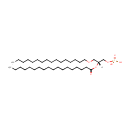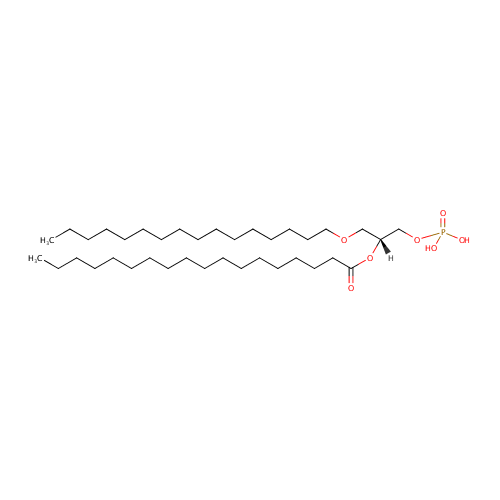|
Record Information |
|---|
| Version |
1.0 |
|---|
| Update Date |
1/22/2018 11:54:54 AM |
|---|
|
Metabolite ID | PAMDB000814 |
|---|
|
Identification |
|---|
| Name: |
PA(16:0e/18:0) |
|---|
| Description: | 2-octadecanoyl-1-hexadecyl-sn-glycero-3-phosphate is an intermediate in ether lipid metabolism. 2-octadecanoyl-1-hexadecyl-sn-glycero-3-phosphate is converted from 1-octadecyl-glycerone-3-phosphate via 1-acylglycerol-3-phosphate O-acyltransferase. (EC: 2.3.1.51) Ether lipids are lipids in which one or more of the carbon atoms on glycerol is bonded to an alkyl chain via an ether linkage, as opposed to the usual ester linkage. Ether lipids are called plasmalogens (1-O-1'-alkenyl-2-acylglycerophospholipids) if these are glycerol-containing phospholipids with an unsaturated O-(1-alkenyl) (vinyl ether) group at the first position on the glycerol chain. Plasmalogens as well as some 1-O-alkyl lipids are ubiquitous and sometimes major parts of the cell membranes in mammals and anaerobic bacteria. In archaea, ether lipids are the major polar lipids in the cell envelope and their abundance is one of the major characteristics that separate this group of prokaryotes from the bacteria. In these cells, diphytanylglycerolipids or bipolar macrocyclic tetraethers can form covalently linked bilayers. |
|---|
|
Structure |
|
|---|
| Synonyms: | - 2-Octadecanoyl-1-hexadecyl-sn-glycero-3-phosphate
- 2-Octadecanoyl-1-hexadecyl-sn-glycero-3-phosphoric acid
- PA(O-16:0/18:0)
|
|---|
|
Chemical Formula: |
C37H75O7P |
|---|
| Average Molecular Weight: |
662.961 |
|---|
| Monoisotopic Molecular
Weight: |
662.525041266 |
|---|
| InChI Key: |
BIMPCBJDAYKNLD-PSXMRANNSA-N |
|---|
| InChI: | InChI=1S/C37H75O7P/c1-3-5-7-9-11-13-15-17-19-20-22-24-26-28-30-32-37(38)44-36(35-43-45(39,40)41)34-42-33-31-29-27-25-23-21-18-16-14-12-10-8-6-4-2/h36H,3-35H2,1-2H3,(H2,39,40,41)/t36-/m1/s1 |
|---|
| CAS
number: |
Not Available |
|---|
| IUPAC Name: | [(2R)-3-(hexadecyloxy)-2-(octadecanoyloxy)propoxy]phosphonic acid |
|---|
|
Traditional IUPAC Name: |
(2R)-3-(hexadecyloxy)-2-(octadecanoyloxy)propoxyphosphonic acid |
|---|
| SMILES: | [H][C@@](COCCCCCCCCCCCCCCCC)(COP(O)(O)=O)OC(=O)CCCCCCCCCCCCCCCCC |
|---|
|
Chemical Taxonomy |
|---|
|
Taxonomy Description | This compound belongs to the class of organic compounds known as 1-alkyl,2-acylglycerophosphates. These are glycerophosphates in which the O-1 atom of the glycerol is bonded to a fatty acid (saturated or unsaturated) through an ether linkage, and the O-2 atom is bonded to another fatty acid through an ester linkage. |
|---|
|
Kingdom |
Organic compounds |
|---|
| Super Class | Lipids and lipid-like molecules |
|---|
|
Class |
Glycerophospholipids |
|---|
| Sub Class | Glycerophosphates |
|---|
|
Direct Parent |
1-alkyl,2-acylglycerophosphates |
|---|
| Alternative Parents |
|
|---|
| Substituents |
- 1-alkyl,2-acyl-glycerol-3-phosphate
- Monoalkyl phosphate
- Glycerol ether
- Fatty acid ester
- Fatty acyl
- Alkyl phosphate
- Phosphoric acid ester
- Organic phosphoric acid derivative
- Organic phosphate
- Carboxylic acid ester
- Monocarboxylic acid or derivatives
- Ether
- Dialkyl ether
- Carboxylic acid derivative
- Hydrocarbon derivative
- Organooxygen compound
- Carbonyl group
- Aliphatic acyclic compound
|
|---|
| Molecular Framework |
Aliphatic acyclic compounds |
|---|
| External Descriptors |
|
|---|
|
Physical Properties |
|---|
| State: |
Solid |
|---|
| Charge: | -2 |
|---|
|
Melting point: |
Not Available |
|---|
| Experimental Properties: |
|
|---|
| Predicted Properties |
|
|---|
|
Biological Properties |
|---|
| Cellular Locations: |
Membrane |
|---|
| Reactions: | |
|---|
|
Pathways: |
|
|---|
|
Spectra |
|---|
| Spectra: |
|
|---|
|
References |
|---|
| References: |
- Kanehisa, M., Goto, S., Sato, Y., Furumichi, M., Tanabe, M. (2012). "KEGG for integration and interpretation of large-scale molecular data sets." Nucleic Acids Res 40:D109-D114. Pubmed: 22080510
- Keseler, I. M., Collado-Vides, J., Santos-Zavaleta, A., Peralta-Gil, M., Gama-Castro, S., Muniz-Rascado, L., Bonavides-Martinez, C., Paley, S., Krummenacker, M., Altman, T., Kaipa, P., Spaulding, A., Pacheco, J., Latendresse, M., Fulcher, C., Sarker, M., Shearer, A. G., Mackie, A., Paulsen, I., Gunsalus, R. P., Karp, P. D. (2011). "EcoCyc: a comprehensive database of Escherichia coli biology." Nucleic Acids Res 39:D583-D590. Pubmed: 21097882
- Uniprot Consortium (2012). "Reorganizing the protein space at the Universal Protein Resource (UniProt)." Nucleic Acids Res 40:D71-D75. Pubmed: 22102590
- Yurtsever D. (2007). Fatty acid methyl ester profiling of Enterococcus and Esherichia coli for microbial source tracking. M.sc. Thesis. Villanova University: U.S.A
|
|---|
| Synthesis Reference: |
Not Available |
|---|
| Material Safety Data Sheet (MSDS) |
Not Available |
|---|
|
Links |
|---|
| External Links: |
| Resource | Link |
|---|
| CHEBI ID | Not Available | | HMDB ID | HMDB11145 | | Pubchem Compound ID | 52929644 | | Kegg ID | Not Available | | ChemSpider ID | 24766519 | | Wikipedia ID | Not Available | | BioCyc ID | Not Available |
|
|---|


